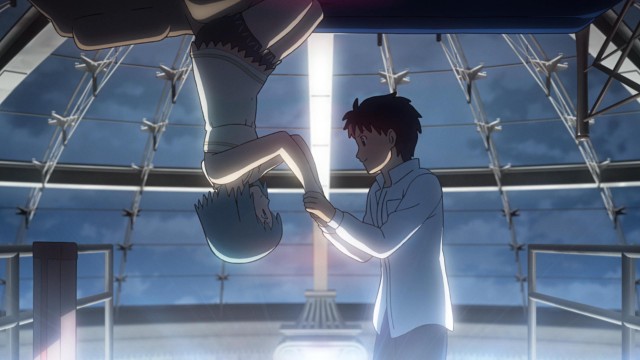This review is of the theatrical Subtitled edition.
The world of Patema Inverted is introduced by an old shaky cam news reel where an off-screen voice is shouting in unsubbed Japanese as the city skyscrapers and office buildings detach and float up into the sky. The unsubbed Japanese dialogue feels important, but because the dialogue is not translated, the scene feels incomplete.
Patema Inverted may feel a bit familiar to those of you who play JRPGs, or saw the Kirsten Dunst vehicle Upside Down. Title character Patema is a princess who will rule her underground civilization as soon as she becomes of age. Her father had died, and her older brother has disappeared, leaving her in the care of the town elder. Being a princess, Patema is supposed to be responsible, but like most Japanese anime kids, she’s curious and loves going to the Danger Zone, a very long vertical shaft where dust floats up.
Patema’s older brother, Lagos, sparked her curiosity when he gave her a Polaroid of a wide open field on which he scrawled “The Real World.” Oh, and it’s gravity fell up, so it rested on the ceiling. When Patema falls down the shaft of the Danger Zone, she ends up in the world of Aiga, where her gravity makes her fall toward the sky, but the people of Aiga walk on their ground. Here, she’s discovered by Eiji, on whom she becomes dependent in a world where they are taught to hate Inverts.
This multi-layered world of Patema Inverted doesn’t make any logical sense, nor is given one by the end of the movie. I suppose that could be a spoiler of sorts. If you’re waiting for Patema Inverted to explain why the worlds existed in the fashion they exist, it’s all explained away as the result of “an experiment.” This is perhaps the biggest flaw of the movie; that is, if you’re looking for a solid air-tight logically-sound movie about a world where people have different gravities.
Patema Inverted‘s world is an allegory for our real world. Much like the world of Patema Inverted, we have become so polarized, we see the opposition as upside down and label them all with broad strokes as evil or sinners. The obvious allegorical meanings of this world are made time and again throughout the film, as bluntly as possible. The goal of the film’s characters, and the film itself, is to reunite the different sides in order to achieve a peaceful harmony.
A major problem with the allegory is that Patema begins the movie as a strong and curious heroine, curious and rebellious but still respectful. She explores the Danger Zone, falls down giant shafts and bravely goes after her backpack that’s at the bottom of an upside down fence. But, once she ends up in Aiga, she becomes a treasure that everybody wants.
One of her underground keepers is a slightly-older boy who loves her, and wants Patema to choose him as her suitor. Later, Patema becomes dependent on Eiji. Even later, the villain’s ultimate goal is to have Patema be dependent on him. Her ineffectualness increases over the course of the film, eventually turning her into a trophy waiting for the right prize to win her over. The most insulting scene happens after she is kidnapped. When the villain keeps her on a bed high above the world with an inverse weight shackled to her ankle, she doesn’t even try to use it to escape even though she’s left alone unshackled for hours at a time and they left a scaffolding leading to her bed. For a movie that gets a lot of weight out of inverted gravities, this sequence felt particularly gross, even if the message was that people have to work together to accomplish tasks. This transformation of Patema from curious princess to ineffective trophy almost becomes its own commentary on the unnoticed sexism in Japanese film, where the female is frequently a passive object.
The somewhat simplistic allegory is the entirety of the world’s logic. The plot of the movie is sweet and nice and entertaining, and the allegory holds up to a cursory scrutiny but, because the plot device doesn’t have a logically-sound drum-tight explanation, the allegorical elements feel a little bit softer. The explanations are not even Donnie Darko-esque where the plot devices of the new world could be left to interpretation. This reason behind the world is just explained away in a Star Trek-style one-off. Which brings us back to the beginning of the movie. I don’t know if the experiment is explained in the first scene of the film. I would love to know because I spent most of the time wondering about the hows or whys of the movie, rather than pondering on the allegorical messages the movie was trying to convey.
This weakish plot is a shame because the movie is gorgeous. The visual language that Yasuhiro Yoshiura employs is stunning and sumptuous. The risk of falling off a building is scary enough, but when that fall leads to nothing, the world becomes even more frightening. Yoshiura’s dizzying imagery plays the traditional anime-style animation for all it’s worth, being soft, fuzzy, and lens flare-y during touching moments, flattish during boring moments, dizzying during scary moments, and deep during the moments of awe. Sure some of the iconography may be a bit familiar and rote to anime regulars, but the icons have rarely been this stunningly realized.
Leaving the theater after Patema Inverted, one is left vaguely unsatisfied because of the logical leaps, but satisfied because of the mild allegorical resonance and stunning visuals. Yoshiura has crafted a stunning film with a great concept whose script needed just a bit more time to bake in the oven.

